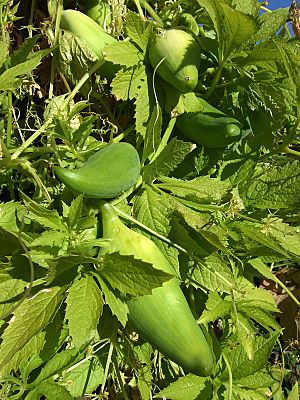Caigua facts for kids
Quick facts for kids Caigua |
|
|---|---|
 |
|
| Scientific classification | |
| Genus: |
Cyclanthera
|
| Species: |
pedata
|
The Caigua (scientific name: Cyclanthera pedata) is a special type of vine that grows tasty fruit. This fruit is mostly eaten as a vegetable. People have been growing and eating caigua for hundreds of years, especially in Peru. We know this because ancient artworks from Peru show pictures of the caigua fruit!
Contents
Where Caigua Comes From
We don't know exactly where caigua first grew in the wild. But we think it came from the Andes mountains in South America. People there have been growing it for a very long time.
What Caigua Looks Like
The caigua plant is a vine that can grow very long, up to 12 meters! Its stems are thin, and its leaves can be up to 24 cm long. The leaves look a bit like a hand with fingers spread out. The flowers are small and can be greenish or white.
The fruit is light green and shaped like an oval, often a bit curved. It can be up to 15 cm long. Inside, it's mostly hollow, except for the seeds and a thin layer of flesh. The skin can be smooth or have soft spines. The seeds inside are black.
How Caigua is Grown
People grow caigua on small farms in the mountain areas of Mexico, Central America, and South America. Sometimes, it's also grown in Asia. This plant can grow in mountains up to 2000 meters high because it likes cooler weather.
Different Names for Caigua
In the Andes mountains, people call it caigua or caihua. Another name is achocha. In English, you might hear it called stuffing cucumber or slipper gourd. In Costa Rica, it's called Jaiva, and in Darjeeling, India, it's known as Chuchay Karela. In Chinese, it's called 小雀瓜.
How People Use Caigua
Caigua as Food
People usually eat the caigua fruit after taking out the seeds. Then, they stuff it with other foods like rice or meat and cook it. You can also eat the young shoots and leaves, just like other green vegetables. Caigua fruits are good for you because they have important minerals like potassium, magnesium, and phosphorus. The taste of the fruit is a bit like a cucumber mixed with a green bean, or sometimes it doesn't have much taste at all.
| Nutritional value per 100 g (3.5 oz) | |
|---|---|
| Energy | 17 kcal (71 kJ) |
|
4 g
|
|
| Dietary fiber | 0.7 g |
|
0.1 g
|
|
|
Protein
|
0.6 g
|
| Vitamins | Quantity
%DV†
|
| Thiamine (B1) |
3%
0.04 mg |
| Riboflavin (B2) |
3%
0.04 mg |
| Niacin (B3) |
2%
0.3 mg |
| Vitamin C |
17%
14 mg |
| Minerals | Quantity
%DV†
|
| Calcium |
1%
14 mg |
| Iron |
2%
0.21 mg |
| Magnesium |
2%
8.4 mg |
| Phosphorus |
4%
26 mg |
| Potassium |
5%
152 mg |
| Sodium |
0%
0.91 mg |
| Other constituents | Quantity |
| Water | 94.1 % |
| †Percentages estimated using US recommendations for adults. | |
Good Things in Caigua
Caigua fruits have special parts called flavonoids. These can help protect your body's cells. Eating foods with flavonoids might even help keep your heart healthy.
However, it's good to know that caigua seeds have something called trypsin inhibitors. These can make it a bit harder for your body to use the protein from your food.
Caigua in History
The ancient Moche culture often drew pictures of caigua on their pottery. This shows how important the plant was to them. Scientists have also found parts of caigua plants buried at old places where people used to live along the coast of Peru.

See also
 In Spanish: Caigua para niños
In Spanish: Caigua para niños



